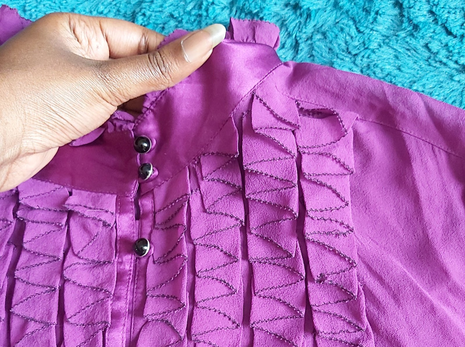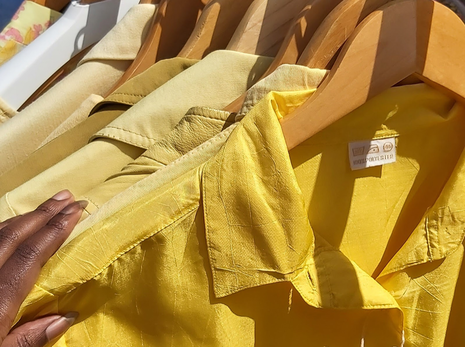Leading the charge against polyester
Material makes all the difference when buying new summer clothes. Natasha Sauvage has become a pro at choosing the best fabrics

On a sunny day with my heavy trench coat swinging at my weary ankles, I found myself stumbling into one of Cambridge’s many high street retailers at the behest of my extremely eager housemate. Bombarded with bright red and bustling sales racks, I felt as if I’d just been tossed into a pool fully clothed. It marked the first time in two years that I’d set foot into a high street retailer — and it very quickly reminded me why. Modern retailers dazzle and bombard customers with sales tags to make us feel as if we’re not getting ripped off with clothes that simply aren’t fit for purpose.
“So you, the inquisitive reader, might ask: how do I make better choices when shopping?”
My housemate held up a breezy white blouse, declaring that it would be great for summer. Taking the blouse into my hands and flicking up the right side of the hem for a material tag, I was able to give her an instant warning.
“It’s 100% polyester. This is the worst thing you could wear during summer — unless you enjoy being hot.”
So you, the inquisitive reader, might ask: how do I make better choices when shopping? The answer is simple. Equip yourself with the knowledge to know what you’re actually buying. In the case of mass-produced retail clothing, it’s as simple as checking for a fabric label.
When it comes to second-hand clothing or vintage clothing, this becomes a little more difficult. If you frequent charity shops often enough, you have likely experienced the spark of joy at finding a gorgeous blouse in the midst of an almost immortal chain of Zara tops, only to flick the blouse open and see no tags in sight. Your fingers brush the blouse and the fabric feels a little gritty, smooth in some parts — must be polyester, right?

In the case of this blouse? Nope. It’s 100% pure silk. It simply features a blend of silk satin and chiffon silk.
One fabric can be made using several different types of materials: for example, satin has a reputation for being a luxurious fabric due to its quality of being smooth and silky — however, it can only truly be considered ‘luxurious’ if it’s silk satin. Polyester satin is much more common these days, and as they are the same type of fabric, it can be difficult to distinguish between them. Touch alone will not tell the full story. Therefore, it is necessary to consider both the properties of the individual garment and how it moves in order to ascertain what the true make up of the fabric is. Polyester as a material is wrinkle-resistant; silk, on the other hand, wrinkles much more easily. Referring to our lovely purple blouse from earlier, wrinkling can indeed be seen in the chiffon: this is a classic tell-tale sign of what material we may be dealing with. Understanding the qualities of the materials that are used to create the fabrics is the key towards being able to identify what’s in your wardrobe.

A key thing to understand is that the unsubstantiated use of polyester as a way to cut costs is not about making fashion affordable. If it was, there wouldn’t be a deluge of cheaply-made clothes clogging up charity shops and online marketplaces. It is about fast, easy profit.
“Let us not forget that people are dying for the sake of £2 polyester garments that can be replicated stitch-for-stitch using cotton”
In the past, clothes were tailored with purpose in mind: summer tops made out of cotton for maximum breathability; winter clothes made with layer after layer of insulating polyester for maximum heat retention. Today, polyester is the default for most high street retailers — with certain big names being the worst offenders for this — and their customers eat this up, not realising that they’re shooting themselves in the foot. Polyester traps sweat against the skin, preventing it from breathing and leading to inflammation of the skin. Let us not forget that people are dying for the sake of £2 polyester garments that can be replicated stitch-for-stitch using cotton.
As we navigate a cost of living crisis, it is infinitely more important that we invest in garments that will last. Companies know this. It’s why they’ll describe their clothes as having a “satin lining” or “velvet finish” so that our brains do the work of linking their product to luxury, when in reality, it is likely a cheaply-made and massively overpriced polyester garment. Only a dishonest, unethical brand would feel the need to obscure the facts. We must take the power back from these brands by arming ourselves with the correct knowledge.
Look at the tags — they’re there for a reason. If you see the dreaded “100% polyester” tag on a garment that could have just as easily been made out of silk or cotton, steer clear and invest in a better wardrobe that will see you well into the future.
 News / Cambridge students set up encampment calling for Israel divestment6 May 2024
News / Cambridge students set up encampment calling for Israel divestment6 May 2024 News / Cambridge postgrad re-elected as City councillor4 May 2024
News / Cambridge postgrad re-elected as City councillor4 May 2024 News / Proposed changes to Cambridge exam resits remain stricter than most7 May 2024
News / Proposed changes to Cambridge exam resits remain stricter than most7 May 2024 News / Some supervisors’ effective pay rate £3 below living wage, new report finds5 May 2024
News / Some supervisors’ effective pay rate £3 below living wage, new report finds5 May 2024 Fashion / Class and closeted identities: how do fits fit into our cultures?6 May 2024
Fashion / Class and closeted identities: how do fits fit into our cultures?6 May 2024






